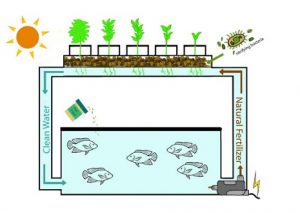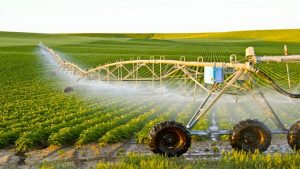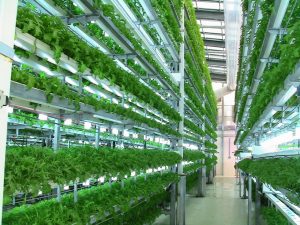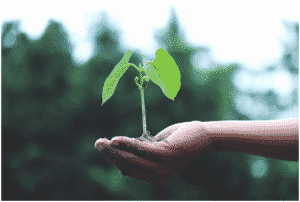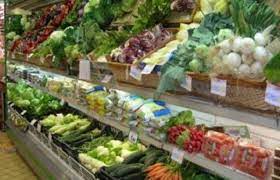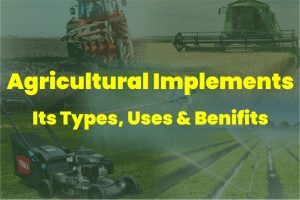Overview of Hydroponic Systems & Farming
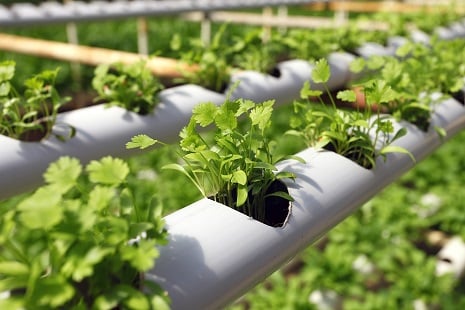
Hydroponic Farming
The term hydroponic system is derived from the combination of two Greek words, hydro, which means water, and ponos, which means work. The term was coined by W. F. Gericke in a scientific journal article published in February 1929. Dr. Gericke, a California professor who began developing what was formerly a laboratory procedure into a commercial method of cultivating plants.
He proposed that agricultural production would no longer be “chained to the earth,” but that some commercial crops might be produced in bigger quantities without dirt in basins holding plant feeding solutions.
What Dr. Gericke did not anticipate was that hydroponic growing would be primarily used in enclosed surroundings to grow high financial value crops and would not be used to produce a diverse variety of commercially cultivated crops in an open environment.
During World War II, the United States Army employed hydroponic culture to generate fresh food for troops stationed on barren Pacific islands. There were profitable commercial farms in America, Europe, Africa, and Asia by the 1950s.
Hydroponic Farming Definition
Hydroponics is the growing of plants in nutrient-rich water, with or without the mechanical support of an inert medium such as sand or gravel. It is also known as aquaculture, mariculture, soilless culture, or tank farming.

Plants have traditionally been cultivated with their roots submerged in water and fertilizer solutions in order to conduct scientific investigations on their nutrition. This type of cultivation was used in early commercial hydroponics (from Greek hydro, “water,” and ponos, “labor”).
However, due to the problems in maintaining the plants in a typical upright growth posture and aerating the solution, this approach was substituted by gravel culture, in which the plants are supported by gravel in a waterproof bed or bench. Various types of gravel and other materials, such as fused shale, clay, and granite chips, have been employed effectively.
Requirements For Hydroponic Farming
Pure water.
We’re talking about high-quality, filtered water with a pH that’s just right. Most plants like water with a pH level of 6–6.5. Over-the-counter remedies available at your local hardware, garden, or hydroponic store can be used to modify the acidity of your water.
Don’t let your plants drown! Roots in traditional farming can obtain the oxygen they require for respiration from pockets of air in the soil. Depending on your hydroponic system, you’ll either need to leave space between the base of your plant and the water reservoir, or you’ll need to oxygenate your container (like bubbles in a fish tank), which you can do by purchasing an air stone or installing an air pump.
Root Assistance.
Even though you don’t need soil, your plant’s roots still require something to cling to. Typical materials include coconut fiber, vermiculite, peat moss, perlite, and rock wool. Avoid materials that may compress (such as sand) or that do not hold any moisture (like gravel).
Nutrients.
To be healthy and prolific, your plant will require lots of magnesium, phosphorus, calcium, and other minerals, just as plants grown in the ground require nutritious soil and fertilizer. When growing plants without soil, this “plant food” must be mixed into the water that your plants are fed. While you may theoretically manufacture your own nutrient solution, it’s far easier to buy ready-made combinations online and in stores.
Light.
If you’re growing plants indoors, you may need to purchase some specialized lights. Each type of plant will have a unique demand for the amount of light it requires as well as the positioning of lights (typically referred to as Daily Light Integral or DLI).
While there are more factors to consider as the sophistication of your hydroponic farm grows (for example, CO2 supplementation), the five stated above are the most fundamental components of any hydroponic system.
By monitoring and modifying these important elements, you may begin to learn exactly what your plants require to thrive and reproduce those circumstances for future development.
Hydroponic System
Hydroponic systems can be either liquid or aggregate in nature. There is no supporting medium for plant roots in liquid environments.
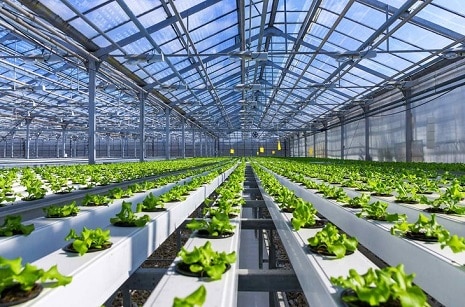
Aggregate systems, on the other hand, have a solid medium of support.
Hydroponic systems are further classified as open (once installed) or closed (once installed).
The nutritional solution is given to the plant roots and is not reused) or closed (excess solution is recovered, refilled, and reused).
Liquid Hydroponic System
They are both closed systems.
• Nutrient Film Technique (NFT): Plants are put in a polyethylene tube with openings made in plastic to allow the roots to grow. This tube is used to provide a nutrient solutions.
• Floating Hydroponics: Plants are cultivated on a raft of inflated plastic that floats in the water.
• Aeroponics: Plant roots are hung in an enclosed growth chamber and sprayed with a mist of nutritional solution at regular intervals, generally every few minutes.
Hydroponic Aggregate System
System that is open
• Rockwool Culture: This is the most often used medium in hydroponics. Rockwool is made from ground-up basalt rock that is heated and spun into threads to create wool. It is extremely light and is frequently offered in cubes. Rockwool can contain water while still retaining enough air space (at least 18%) to allow optimal root development.
• The Sand Culture
System that is closed
• Sand and gravel
• NFT with Rockwool: Plants are grown on tiny Rockwool slabs placed in channels filled with recycled nutrient solution.
Types Of Hydroponic Systems
The Water Culture System
This is the “mother of all hydroponic systems,” the most traditional, even historical approach. However, it is not a favorite among hydroponic growers, as we will see shortly. It’s a basic approach that’s a “step-up” from the Kratky method.
It is built around a tank (called a grow tank) that contains the fertilizer solution as well as at least one air pump to deliver oxygen to the roots.
This is the most basic form. With an air pump, you can grow more plants more effectively in a single grow tank.
Ebb and Flow System
The Ebb and Flow System works by momentarily flooding the grow tray with nutritional solution before draining it back into the reservoir. This is often accomplished using a submersible pump linked to a timer. The timer is configured to turn on multiple times per day, depending on the size and kind of plants, temperature, humidity, and growth media type.
Drip systems
Drip systems are the most common form of hydroponic system in the world.
The drip system is a fantastic answer to the “major problem” of aeration. At the same time, it supplies regular nourishment and watering through the employment of a very simple concept: pipes, hoses, and a growth medium.
It is gaining popularity and is already the standard in hot and arid areas, where long pipelines and hoses are used to irrigate fields, conserving water and reducing evaporation.
Nutrient Film Technique
Because NFT Systems feature a continual supply of nutrient solution, the submersible pump does not require a timer.
Researchers have created yet another technology, NFT, or nutrient film technique, in an effort to find a solution to the problem of aeration.
With NFT, you will only give a thin layer of solution (a “film” in actuality) at the bottom of a rather deep tank. The bottom half of the roots will absorb nutrients and water as a result, while the higher section will breathe.
Researchers observed that plants respond to this strategy by producing roots that reach the film and then spread horizontally.
Aeroponic System
The Aeroponic System is the most advanced method of hydroponic farming. A timer operates the nutrient pump in the same way as it does in other types of hydroponic systems, with the exception that the aeroponic system requires a short cycle timer that runs the pump for a few seconds every couple of minutes.
This is sprayed to the roots in the form of droplets as it passes through the nozzles.
This implies that the roots will obtain moisture and nutrients while also having the ability to breathe freely.
Techniques for Nutrient Management
The main drawback of a closed system is the difficulty in managing nutrients. There are four major methods.
1st Technique
All of the water addition, pH, and electrical conductivity (EC) controls are automated. The pH measures the acidity of the substrate and regulates the availability of mineral nutrients, whereas the EC estimates the nutrient concentration.
Because the total availability of nutrients is best at a slightly acidic pH, the suggested pH for hydroponic culture is between 5.0 and 6.0, and the EC level should be 1.5 to 3 dS m-1.
2nd Technique
The water composition of the holding tank is automated, generally via a float valve, which keeps the tank level constant. Both water and nutrients are absorbed here, but only water is restored. As a result, the EC will decline until the tank solution is strengthened by fertilizer input. The EC is monitored on a regular basis and adjusted to the necessary amount by manually adding nutrients to the tank.
If necessary, the pH is changed by adding acid (dilute sulfuric acid) to decrease it or alkali (dilute sodium hydroxide (NaOH) solution) to increase it.
3rd technique
The holding tank is partially or totally depleted, then replenished in batches with water and/or nutrients. The fact that the consequences of the addition are examined is a key component of this approach.
4th technique
The holding tank is partially or entirely depleted before being replenished with a standard strength nutrition solution. The resulting EC in the system, however, is not examined or changed. This method has the potential to be disastrous.
Crops Grown in Hydroponic Farming
Hydroponic farming allows us to cultivate a variety of crops, fruits, and plants.
Lettuce, beans, spinach, cabbage, bell peppers, chives, blueberries, kale, basil, grapes, celery, sage, cantaloupe, carrots, cauliflower, chard, broccoli, corn, cucumbers, melons, tomatoes, bell peppers, berries
Advantages of hydroponic Farming
- Plants may be cultivated all year round.
- Increased control over growth conditions leads to higher crop yields and shorter growing times.
- There’s no need to weed.
- Saves up to 90% of the water.
- There is no requirement for crop rotation.
- Plants can be piled vertically and positioned closely together.
- Materials are reusable.
Disadvantages of Hydroponics Farming
- Higher initial expenditures as compared to soil growing techniques.
- When diseases are prevalent, they spread quickly.
- To maintain, some fundamental skills and expertise are required.

